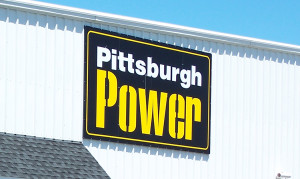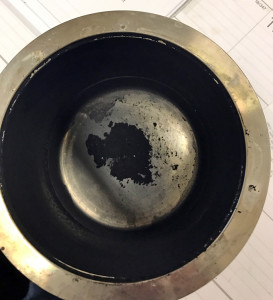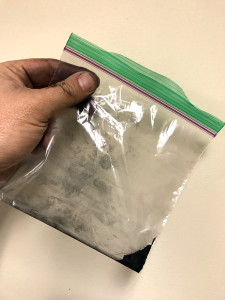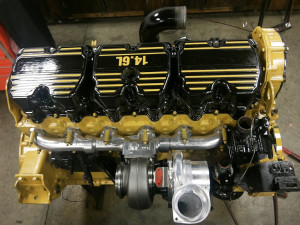 What is it that you want out of your truck? Our goal at Pittsburgh Power is to help you love your truck by improving it. When you love your truck because of these improvements, the benefits are plentiful. First off, you will enjoy driving it so much more. You will also drive the truck easier, with less pressure on the throttle, because your engine will respond to even slight movements of your right foot. The truck will be better maintained and kept cleaner because it makes you feel good. When you park your truck at a truck stop and walk towards the restaurant, there will be a smile on your face when you turn back to look at it because of how you feel towards that piece of equipment. A great-running truck is a “win-win” situation – not only will the mileage improve, the truck will last twice as long because of the care you will give it, as opposed to a truck that irritates you.
What is it that you want out of your truck? Our goal at Pittsburgh Power is to help you love your truck by improving it. When you love your truck because of these improvements, the benefits are plentiful. First off, you will enjoy driving it so much more. You will also drive the truck easier, with less pressure on the throttle, because your engine will respond to even slight movements of your right foot. The truck will be better maintained and kept cleaner because it makes you feel good. When you park your truck at a truck stop and walk towards the restaurant, there will be a smile on your face when you turn back to look at it because of how you feel towards that piece of equipment. A great-running truck is a “win-win” situation – not only will the mileage improve, the truck will last twice as long because of the care you will give it, as opposed to a truck that irritates you.
We have great news for owners of PACCAR engines. We have now installed our patented Pittsburgh Power Soot Separator on a test truck equipped with a PACCAR engine (we also did an emissions tune-up and rebuilt and cleaned many of the truck’s sensors). The engine is running like new, and after a quick 10-mile drive, the soot separator had already pulled enough soot out of the EGR return line to completely cover the bottom of the trap!
This latest truck is a 2013 KW T-800 with a PACCAR MX-13 engine. The first soot separator was installed on a DD-15 Detroit, and the fuel mileage on that rig has improved by over one mile-per-gallon and the soot separator is working perfectly, removing most of the soot from the exhaust gases. Next month, we will have a report on the PACCAR engine, including how much soot has been eliminated from the intake manifold and if any mileage or performance improvements have been realized. As of now, our thoughts are that the performance will improve because the elimination of the soot allows for a more complete burn, less emissions and more horsepower. Stay tuned.
 Here is a quick note about coolant level in the radiator. After an engine has had all the coolant drained from the radiator and engine block, such as when an in-chassis rebuild or head gasket replacement is done, you must, for the next several days, check the coolant level and add coolant as needed. There are air pockets in the engine block, and even after running the engine on the dyno, we check the coolant level and top if off, if necessary. However, sometimes the air does not escape from the block until after the truck pulls a load, so keep an eye on the coolant level for the next several days after it is drained.
Here is a quick note about coolant level in the radiator. After an engine has had all the coolant drained from the radiator and engine block, such as when an in-chassis rebuild or head gasket replacement is done, you must, for the next several days, check the coolant level and add coolant as needed. There are air pockets in the engine block, and even after running the engine on the dyno, we check the coolant level and top if off, if necessary. However, sometimes the air does not escape from the block until after the truck pulls a load, so keep an eye on the coolant level for the next several days after it is drained.
We are seeing a huge increase in sales of 1999 and older used trucks. Naturally, most of the phone calls I get about these trucks start out with, “What can I do to increase the fuel mileage?” The following is a list of the items we have for the Cummins, Caterpillar and Detroit engines. If you trust me enough to make these changes, and I hope you do, you will love your truck and trucking will be more fun.
The first items I recommend to improve the performance and efficiency of your older truck are the washable and re-usable foam Fleet-Air filters and our straight-through quiet performance muffler. These two items alone, when combined, usually render at least half a mile-per-gallon improvement. They are also inexpensive, so there is no excuse for you not to have them on your truck. Just do it!
 The next items on our “must have” parts list are the torsional vibration damper and mercury-filled engine balancer. The torsional damper is a must to replace (the silicone hardens after 500K miles), and the balancer makes the engine much smoother (and is good for life). These two items are also inexpensive and can do wonders to preserve the life of the engine, the clutch, and your body. The torsional damper will eliminate broken crankshafts, camshafts and accessory drive shafts, broken springs in the clutch disc, broken bolts that hold the flywheel to the crankshaft, broken flywheel housing bolts, broken alternator and air conditioning brackets, and help to alleviate vibrations in the cab. The torsional damper is a wear item, and it must be replaced every 500,000 miles or 10 years. Please, do yourself a favor and purchase your damper from Pittsburgh Power – if you buy it from a truck dealer or engine dealership, you will get one made in China or India (ours are made in the USA by the inventors of the silicone-filled torsional damper).
The next items on our “must have” parts list are the torsional vibration damper and mercury-filled engine balancer. The torsional damper is a must to replace (the silicone hardens after 500K miles), and the balancer makes the engine much smoother (and is good for life). These two items are also inexpensive and can do wonders to preserve the life of the engine, the clutch, and your body. The torsional damper will eliminate broken crankshafts, camshafts and accessory drive shafts, broken springs in the clutch disc, broken bolts that hold the flywheel to the crankshaft, broken flywheel housing bolts, broken alternator and air conditioning brackets, and help to alleviate vibrations in the cab. The torsional damper is a wear item, and it must be replaced every 500,000 miles or 10 years. Please, do yourself a favor and purchase your damper from Pittsburgh Power – if you buy it from a truck dealer or engine dealership, you will get one made in China or India (ours are made in the USA by the inventors of the silicone-filled torsional damper).
My next advice, if you buy an older truck, would be to clean and repair the ECM. After a period of years, the ECM will collect moisture, sometimes oil, and diesel fuel. We remove the cover from the ECM, give it a visual inspection, and clean any corroded connections. If it’s a Detroit DDEC4, we will replace the battery, which holds the memory. Then, we calibrate it and set the horsepower and torque to meet your demands. The final process for the ECM is to run it on our desktop simulator (we can duplicate everything it does on our simulator). Now, the engine will produce more horsepower and torque.
 The next improvement I recommend is the Full Tilt ported and ceramic-coated exhaust manifold. This manifold will flow 20% more exhaust and allow the exhaust gas temperature to run 125-degrees cooler. There will be no leaks, thanks to the unit’s tight tolerances, and it will not crack, thanks to extra gussets added where stock manifolds tend to crack. Along with the higher-flow exhaust manifold comes the 15% larger turbo. As exhaust flow increases, the size of the turbine housing on the turbo must also increase. The ECM programing, exhaust manifold and turbocharger will allow the engine to produce another three-quarter to one mile-per-gallon of fuel savings.
The next improvement I recommend is the Full Tilt ported and ceramic-coated exhaust manifold. This manifold will flow 20% more exhaust and allow the exhaust gas temperature to run 125-degrees cooler. There will be no leaks, thanks to the unit’s tight tolerances, and it will not crack, thanks to extra gussets added where stock manifolds tend to crack. Along with the higher-flow exhaust manifold comes the 15% larger turbo. As exhaust flow increases, the size of the turbine housing on the turbo must also increase. The ECM programing, exhaust manifold and turbocharger will allow the engine to produce another three-quarter to one mile-per-gallon of fuel savings.
Now, for the icing on the cake, we recommend installing the FASS Fuel System. This system removes the air from the diesel fuel. Caterpillar says that fuel can have as much as 10% air entrapped in it, and you do not want this air to travel to the injectors – the FASS system will remove it. The engine will also gain about 30 hp and about 3/10th mile-per-gallon. Of course, if your desire to have adjustable power and torque at your fingertips, the Pittsburgh Power computer is the way to go. It has 7 to 9 settings and can be changed with the touch of a button or the turn of a dial as you drive. It also tells you the turbo boost and exhaust gas temperature, which are important things to know.
With these changes, your older truck’s fuel mileage will improve, along with engine performance, and the longevity of the engine itself will increase. Your driving pleasure will also improve, and that tried and true classic 1999 and older tractor will certainly put a smile on your face. If you have any comments or questions, I can be reached at Pittsburgh Power in Saxonburg, PA at (724) 360-4080.
